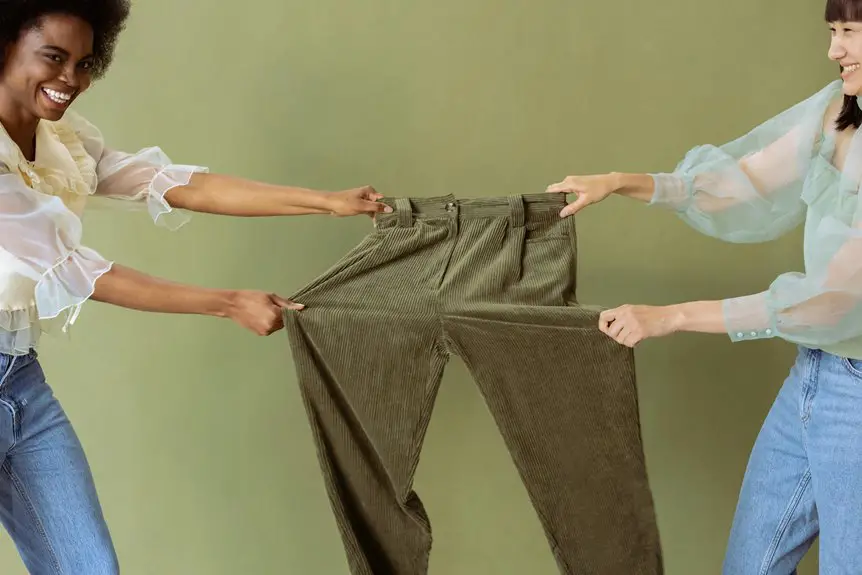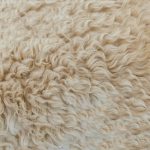You’ll find polyamide excels in durability, quick-drying, and abrasion resistance, making it great for tough, long-lasting garments. Elastane, on the other hand, gives your clothes incredible stretch and shape retention, perfect for comfort and movement. Polyamide feels smooth but less stretchy, while elastane molds to your body but needs gentle care. Blends of both balance toughness and flexibility. To get the best fit for your needs, it helps to explore their unique benefits further.
Table of Contents
Key Takeaways
- Polyamide is durable, abrasion-resistant, and quick-drying, ideal for tough outerwear and activewear.
- Elastane offers exceptional stretch and shape retention, perfect for sportswear and form-fitting garments.
- Polyamide provides moisture-wicking and chemical resistance but may pill and retain odors over time.
- Elastane is lightweight and flexible but less durable and sensitive to heat and harsh chemicals.
- Blending polyamide with elastane balances toughness with stretch, enhancing comfort and garment performance.
Characteristics of Polyamide
Polyamide, commonly known as nylon, offers impressive strength and durability, making it a popular choice in textiles.
When you use polyamide, you benefit from its lightweight yet tough nature, which resists abrasion and wear. It dries quickly, so you won’t have to worry about lingering moisture or mildew.
Thanks to its smooth texture, polyamide fabrics feel comfortable against your skin and resist wrinkles, keeping your clothes looking fresh. You’ll also appreciate its resistance to chemicals and oils, which helps maintain the fabric’s appearance over time.
Polyamide’s smooth texture ensures comfort and wrinkle resistance, while its chemical resilience keeps fabrics looking fresh longer.
While polyamide is strong, it’s also flexible enough to provide ease of movement. Just remember, it’s prone to static buildup, so you might want to use an anti-static spray or fabric softener when you wear it.
Properties of Elastane
While polyamide provides strength and durability, elastane offers something different: exceptional stretch.
When you wear elastane, you experience fabric that can stretch up to five times its original length and then bounce back without losing shape. This elasticity makes it perfect for garments that need freedom of movement.
Elastane also feels lightweight and smooth against your skin, enhancing comfort during wear. It resists perspiration and body oils, so it stays resilient and doesn’t degrade quickly.
Though it’s not as strong on its own, elastane’s flexibility and recovery properties make it invaluable when blended with other fibers. You’ll find it maintains its stretchiness even after multiple washes, ensuring your clothes stay snug and supportive over time.
Common Uses in Apparel
Stretch and durability play key roles in choosing fabrics for your wardrobe.
Polyamide, known for its strength and resistance to wear, often appears in outerwear, activewear, and hosiery. You’ll find it in jackets, leggings, and tights where durability matters.
Elastane, with its exceptional stretch, is common in sportswear, underwear, and swimwear, giving you the freedom to move comfortably.
Many garments blend polyamide with elastane, combining resilience with flexibility.
When you pick clothes for workouts or daily wear, these fibers work together to offer support and comfort.
Benefits and Drawbacks of Each Fiber
Because you want fabrics that perform well and last, understanding the benefits and drawbacks of polyamide and elastane is essential.
Polyamide offers excellent durability, moisture-wicking, and quick-drying properties, making it great for activewear. However, it can retain odors and may pill over time.
Elastane, on the other hand, provides outstanding stretch and shape retention, giving you comfort and flexibility. It resists wrinkles but is less durable on its own and can degrade with excessive heat or chemicals.
While polyamide excels in strength and moisture management, elastane shines in elasticity and fit. Knowing these strengths and limitations helps you appreciate why blends often combine both fibers, balancing performance and comfort to meet your specific needs.
How to Choose Between Polyamide and Elastane
How do you decide which fiber suits your needs best? Start by considering what you value most in your fabric.
Polyamide offers durability and moisture-wicking, ideal for activewear. Elastane provides exceptional stretch and comfort, perfect for form-fitting clothes.
Here’s how to choose:
- Purpose: Need toughness or flexibility? Polyamide resists wear; elastane stretches.
- Comfort: Elastane molds to your body, polyamide feels smooth but less stretchy.
- Care: Polyamide is easy to maintain; elastane requires gentle handling.
- Blends: Many garments combine both for balanced performance—consider blends for versatility.
Frequently Asked Questions
Are Polyamide and Elastane Environmentally Sustainable?
You shouldn’t assume all fabrics are eco-friendly. Both polyamide and elastane come from synthetic sources, often relying on fossil fuels, so they aren’t very sustainable. However, recycled versions can reduce environmental impact considerably.
How Do Washing Methods Differ for Polyamide and Elastane?
When washing, treat delicate fibers like fragile whispers—use cold water and gentle cycles. Polyamide prefers mild detergents, while elastane needs careful handling to maintain stretch. Avoid heat; it’s the enemy that can shrink their charm.
Can Polyamide or Elastane Cause Skin Allergies?
You can develop skin allergies from both polyamide and elastane, especially if you have sensitive skin. They might cause irritation or rashes, so it’s best to test new fabrics cautiously and choose hypoallergenic options if needed.
What Is the Cost Difference Between Polyamide and Elastane Fabrics?
You might expect fabrics to cost the same, but elastane usually costs more due to its stretch properties. Polyamide’s cheaper price reflects its durability. Knowing this helps you choose wisely without overspending.
Which Fiber Is Better for Athletic Performance Wear?
You’ll find elastane better for athletic performance wear because it stretches and moves with you, offering flexibility and comfort. Polyamide adds durability and moisture-wicking, but elastane’s elasticity makes it ideal for active gear.
- Are Gore-Tex Shoes a Good Choice for Snow? - July 2, 2025
- Do Gore-Tex Shoes Stretch Over Time? - July 2, 2025
- How to Clean Your Nike Gore-Tex Shoes - July 2, 2025







